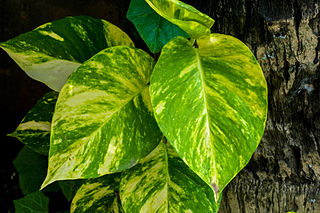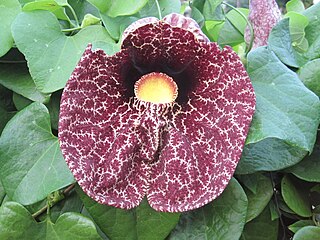
Amorphophallus is a large genus of some 200 tropical and subtropical tuberous herbaceous plants from the Arum family (Araceae), native to Asia, Africa, Australia and various oceanic islands. A few species are edible as "famine foods" after careful preparation to remove irritating chemicals. The genus includes the Titan arum of Indonesia, which has the largest inflorescence of any plant in the genus, and is also known as the 'corpse flower' for the pungent odour it produces during its flowering period, which can take up through seven years of growth before it occurs.

Epipremnum aureum is a species in the arum family Araceae, native to Mo'orea in the Society Islands of French Polynesia. The species is a popular houseplant in temperate regions but has also become naturalised in tropical and sub-tropical forests worldwide, including northern South Africa, Australia, Southeast Asia, South Asia, the Pacific Islands and the West Indies, where it has caused severe ecological damage in some cases.

Monstera is a genus of 59 species of flowering plants in the arum family, Araceae, native to tropical regions of the Americas.

Schinopsis balansae is a hardwood tree known as willow-leaf red quebracho which forms forests in the subtropical Humid Chaco ecoregion of north-eastern Argentina, and Paraguay. It is also found in the wild Pantanal vegetation in Brazil. Some of its vernacular names are quebracho colorado chaqueño and quebracho santafesino. Other species, like Schinopsis lorentzii, bear the general name quebracho and have similar properties and uses. S. balansae shares its habitat with a species of the same genus, S. heterophylla, and the two are often confused.

Dioscorea elephantipes, the elephant's foot or Hottentot bread, is a species of flowering plant in the genus Dioscorea of the family Dioscoreaceae, native to the dry interior of South Africa.

Ceropegia woodii is a flowering plant in the dogbane family Apocynaceae, native to South Africa, Eswatini and Zimbabwe. It is sometimes treated as a subspecies of the related Ceropegia linearis, as C. linearis subsp. woodii. Common names include chain of hearts, collar of hearts, string of hearts, rosary vine, hearts-on-a-string, and sweetheart vine.

Aristolochia littoralis, the calico flower or مورپنکھ بیل or elegant Dutchman's pipe, is a species of evergreen vine belonging to the family Aristolochiaceae.

Anredera cordifolia, commonly known as the Madeira vine or mignonette vine, is a South American species of ornamental succulent vine of the family Basellaceae. The combination of fleshy leaves and thick aerial tubers makes this a very heavy vine. It smothers trees and other vegetation it grows on and can easily break branches and bring down entire trees on its own. Other names include lamb's tail and potato vine.

Vinca major, with the common names bigleaf periwinkle, large periwinkle, greater periwinkle and blue periwinkle, is a species of flowering plant in the family Apocynaceae, native to the western Mediterranean. Growing to 25 cm (10 in) tall and spreading indefinitely, it is an evergreen perennial, frequently used in cultivation as groundcover.

Adenium obesum is a poisonous species of flowering plant belonging to the tribe Nerieae of the subfamily Apocynoideae of the dogbane family, Apocynaceae. It is native to the Sahel regions south of the Sahara, tropical and subtropical eastern and southern Africa and also the Arabian Peninsula. Common names include Sabi star, kudu, mock azalea, impala lily and desert rose. Adenium obesum is a popular houseplant and bonsai in temperate regions.

Araujia sericifera is a perennial vining plant in the genus Araujia, of the family Apocynaceae. The species was described in 1817 by the Portuguese botanist Félix de Avelar Brotero. The synonym Araujia hortorum is in more frequent use in New Zealand. Its common names include moth plant, white bladderflower, common moth vine, cruel vine, and false choko.

Delairea is a plant genus within the family Asteraceae that is native to South Africa. Classified within the tribe Senecioneae, it contains only one species, Delairea odorata, which was previously included in the genus Senecio as Senecio mikanioides. It is known as Cape ivy in some parts of the world (US) and German ivy in others. Other names include parlor ivy and Italian ivy.

Protea welwitschii is a species of shrub or small tree which belongs to the genus Protea, and which occurs in bushveld and different types of grassland.
Alsodeiopsis schumannii is a species of plant in the Icacinaceae family. It is endemic to Tanzania, specifically the East Usambara, the Uluguru Mountains, and the Southern Highlands.

Sesuvium portulacastrum is a sprawling perennial herb in the family Aizoaceae that grows in coastal and mangrove areas throughout much of the world. It grows in sandy clay, coastal limestone and sandstone, tidal flats and salt marshes, throughout much of the world. It is native to Africa, Asia, Australia, Hawai`i, North America and South America, and has naturalised in many places where it is not indigenous.

Senecio tamoides, also known as Canary creeper, false grapevine, and parlor ivy, is a climbing member of the genus Senecio of the family Asteraceae that is native to Southern Africa. It is used as an ornamental plant for its showy yellow, daisy-like flowers in late autumn through to winter.

Epipremnum is a genus of flowering plants in the family Araceae, found in tropical forests from China, the Himalayas, and Southeast Asia to Australia the western Pacific. They are evergreen perennial vines climbing with the aid of aerial roots. They may be confused with other Monstereae such as Rhaphidophora, Scindapsus and Amydrium.

Cassytha filiformis or love-vine is an orangish, wiry, parasitic vine in the family Lauraceae. It is found in coastal forests of warm tropical regions worldwide including the Americas, Indomalaya, Australasia, Polynesia and tropical Africa.

Strychnos usambarensis is a shrub or small tree up to 15m tall or a 70m long liane of Sub-Saharan Africa, occurring in forest and woodland, mountain ravines and coastal bush, often on rocky slopes and named for the Usambara Mountains of Tanzania. The species is found from Guinea east to Nigeria, from Congo east to Kenya and south to kloofs of the Magaliesberg of South Africa. Bantu tribes from Rwanda and Tanzania produce an arrow poison from the root bark and leaves of this species, sometimes combining it with extracts from other plants.

Pterodiscus is a genus of plant in the Pedaliaceae family comprising several species with a native range from Ethiopia to S. Africa. The range passes through the countries of Angola, Botswana,, Ethiopia, Kenya, Mozambique, Namibia, Somalia, Sudan, Tanzania, Zambia and Zimbabwe. Plus it is found also within the Provinces of South Africa in Cape Provinces, Free State, KwaZulu-Natal and Northern Provinces.



















